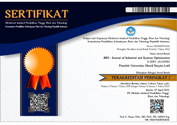HOW TO UTILIZE AUTODESK FUSION 360 THAT REINFORCES PRODUCT REDESIGN SIMULATION?
DOI:
https://doi.org/10.51804/jiso.v6i1.48-54Keywords:
Fusion 360, FEA simulation, optimization, product redesign, structural analysisAbstract
Dalam industri desain saat ini, konsep desain generatif untuk perancangan dan pengembangan produk semakin berkembang. Ketika sebuah produk telah berada di pasar dalam jangka waktu yang lama, kebutuhan redesain produk menjadi hal yang tak terelakkan. Konsep redesain produk memodifikasi produk yang sudah ada untuk meningkatkan fungsionalitas, kegunaan, atau efisiensi manufaktur. Ini melibatkan perubahan desain produk, material, dan aspek lain untuk mencapai tujuan dan menyelesaikan masalah tertentu. Komunikasi antara desainer dan insinyur saat proses redesain produk muncul melalui perbedaan perangkat lunak. Kesulitan juga terletak pada komunikasi pemikiran desain dan strategi pemesinan. Autodesk Fusion 360 adalah perangkat lunak CAD/CAM dan CAE yang komprehensif. Penelitian ini bertujuan untuk menggunakan Fusion 360 untuk memperkuat simulasi desain ulang produk. Desain ulang produk yang lengkap mencakup beberapa bidang penting, termasuk desain industri, desain mekanik, rendering dan animasi, emulasi dengan dibantu komputer (CAE), dan manufaktur yang terintegrasi (CAM). Fusion 360 menyajikan ikhtisar kolaborasi, mendobrak batasan antara seni dan manufaktur, serta mengkritisi konsep desain dan proses manufaktur. Dengan menggunakan perangkat Fusion 360 untuk simulasi, analisis FEA statis dapat divisualisasikan. Untuk studi kasus, diamati bahwa hasil kekuatan, tegangan berada dalam nilai kekuatan luluh kritis dari masing-masing bahan, dengan kustomisasi massal dalam analisis struktur. Sebagai hasil dari analisis struktural selama tahap desain, penilaian sepeda motor kargo roda tiga dalam hal daya tahan dan ketahanan mekanisnya dapat dilakukan tanpa membahayakan pengguna.
ABSTRACT
In today's design industries, the concept of generative design for product development is progressively evolving. When a product has been on the market for an extended period of time, redesigning becomes inevitable. Product redesign refers to modify an existing product to improve functionality, usability, or manufacturing efficiency. It involves changing the product's design, materials, and other aspects to address specific goals and problems. The communication between designers and engineers used to go on through different software products, tool commands, and even industry terms. However, the difficulty also lies in communicating design thoughts and machining strategies. Autodesk Fusion 360 is a comprehensive CAD/CAM and CAE software tool. This article proposes to utilize Fusion 360 for reinforcing product redesign simulation. A complete product redesign covers several significant areas, including industrial design, mechanical design, rendering and animation, computer-aided emulation (CAE), and computer-aided manufacturing (CAM). Fusion 360 presents an overview of collaboration, breaks the barriers between art and manufacturing, and blocks between design and processing. Using Fusion 360 user interface for simulation, the static FEA simulation results can be visualized. For the case study, it is observed that the results for stress and global displacement are within the critical yield strength values of the respective material, with mass customization. As a result of structural analysis during the design stage, the assessment of three-wheeled cargo motorcycle in terms of their durability and mechanical resistance is possible without putting the user at risk. Based on the obtained results, the structure strength was compared.
References
Jumandono, M., & Juniani, A. I. (2017). Analisa Pembuatan dan Perakitan Kerangka Chassis Mobil Minimalis Roda Tiga Menggunakan Metode AHP (Analytical Hierarchy Process). Proceedings Conference on Design …, 1509, 11–14. http://journal.ppns.ac.id/index.php/CDMA/article/download/311/264
Juniani, A., Singgih, M., & Karningsih, P. (2022). Proposed Framework of Product Redesign Need Assessment based on Customer Requirement, Complaint and Failure Analysis. 12th Annual International Conference on Industrial Engineering and Operations Management. https://doi.org/https://doi.org/10.46254/AN12.20220115.
Juniani, A. I., Singgih, M. L., & Karningsih, P. D. (2021). Design for Manufacturing, Assembly and Reliability on Product Redesign: Literature Review and Research Direction. 2nd Asia Pasific Conference on Industrial Engineering and Operations Management, 218–231. http://ieomsociety.org/indonesia2021/proceedings/
Juniani, A. I., Singgih, M. L., & Karningsih, P. D. (2022). Design for Manufacturing, Assembly, and Reliability: An Integrated Framework for Product Redesign and Innovation. Designs, 6(5). https://doi.org/10.3390/designs6050088
Prabowo, R. S., Setiawan, P. A., Juniani, A. I., Wiediartini, & Erawati, I. (2018). Reliability analysis of hanger shot blast KAZO machine in foundry plant. MATEC Web of Conferences, 204. https://doi.org/10.1051/matecconf/201820403007
Rahman, M. F. F., Juniani, A. I., & Setiawan, T. A. (2020). Perancangan Jok Ergonomis Dalam Fabrikasi Mobil Minimalis Roda Tiga. Proceedings Conference on Design Manufacture Engineering and Its Application, 2654.
Setiawan, T. A., Sarena, S. T., Purnomo, D. A., & Juniani, A. I. (2023). Embracing Risk Factors into Product Redesign Model based on DFMA and Concurrent Engineering : A Review for Research Opportunities. 1–6.
Sholeh, A., Iviana Juniani, A., & Novrita Devi, Y. (2018). Analisis dan Perancangan Sepeda Statis untuk Rehabilitasi Penderita Stroke. Politeknik Perkapalan Negeri Surabaya, 11–16.
Zhang, L., Chu, X., & Xue, D. (2019). Identification of the to-be-improved product features based on online reviews for product redesign. International Journal of Production Research, 57(8), 2464–2479. https://doi.org/10.1080/00207543.2018.1521019
Downloads
Published
Issue
Section
License
With the receipt of the article by JISO Editorial Board and the decision to be published, the copyright regarding the article will be transferred to JISO. The copyright transfer form can be downloaded here.
JISO has the right to multiply and distribute the article and every author is not allowed to publish the same article that was published in this journal.
JISO is licensed under a Creative Commons Attribution-ShareAlike 4.0 International License.
Under the following terms:
Attribution — You must give appropriate credit, provide a link to the license, and indicate if changes were made. You may do so in any reasonable manner, but not in any way that suggests the licensor endorses you or your use.
ShareAlike — If you remix, transform, or build upon the material, you must distribute your contributions under the same license as the original.














